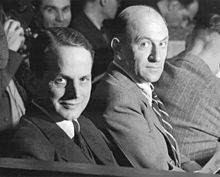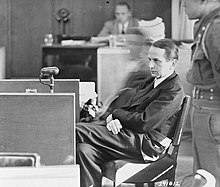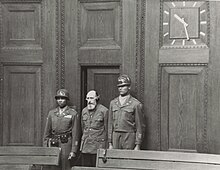| Name |
Photo |
Function |
Sentence |
Outcome, 1951 amnesty |
|---|
| Otto Ohlendorf |
|
SS-Gruppenführer; member of the SD; commanding officer of Einsatzgruppe D |
Death by hanging |
Executed on June 7, 1951[6] |
| Heinz Jost |
|
SS-Brigadeführer; member of the SD; commanding officer of Einsatzgruppe A |
Life imprisonment |
Commuted to 10 years; released in December 1951; died in 1964 |
| Erich Naumann |
|
SS-Brigadeführer; member of the SD; commanding officer of Einsatzgruppe B |
Death by hanging |
Executed on June 7, 1951[6] |
| Otto Rasch |
|
SS-Brigadeführer; member of the SD and the Gestapo; commanding officer of Einsatzgruppe C |
Removed from the trial on February 5, 1948 due to medical reasons |
Died on November 1, 1948 |
| Erwin Schulz |
|
SS-Brigadeführer; member of the Gestapo; commanding officer of Einsatzkommando 5 of Einsatzgruppe C |
20 years |
Commuted to 15 years; released on January 9, 1954; died in 1981 |
| Franz Six |
|
SS-Brigadeführer; member of the SD; commanding officer of Vorkommando Moskau of Einsatzgruppe B |
20 years |
Commuted to 10 years; released in October 1952; died in 1975 |
| Paul Blobel |
|
SS-Standartenführer; member of the SD; commanding officer of Sonderkommando 4a of Einsatzgruppe C |
Death by hanging |
Executed on June 7, 1951[6] |
| Walter Blume |
|
SS-Standartenführer; member of the SD and the Gestapo; commanding officer of Sonderkommando 7a of Einsatzgruppe B |
Death by hanging |
Commuted to 25 years; released in March 1955; died in 1974 |
| Martin Sandberger |
|
SS-Standartenführer; member of the SD; commanding officer of Sonderkommando 1a of Einsatzgruppe A |
Death by hanging |
Commuted to life imprisonment; released on May 9, 1958; died in 2010 |
| Willi Seibert [de] |
|
SS-Standartenführer; member of the SD; deputy chief of Einsatzgruppe D |
Death by hanging |
Commuted to 15 years; released on May 14, 1954; died in 1976 |
| Eugen Steimle |
|
SS-Standartenführer; member of the SD; commanding officer of Sonderkommando 7a of Einsatzgruppe B and of Sonderkommando 4a of Einsatzgruppe C |
Death by hanging |
Commuted to 20 years; released in June 1954; died in 1987 |
| Ernst Biberstein |
|
SS-Obersturmbannführer; member of the SD; commanding officer of Einsatzkommando 6 of Einsatzgruppe C |
Death by hanging |
Commuted to life imprisonment; released on May 9, 1958; died in 1986 |
| Werner Braune |
|
SS-Obersturmbannführer; member of the SD and the Gestapo; commanding officer of Einsatzkommando 11b of Einsatzgruppe D |
Death by hanging |
Executed on June 7, 1951[6] |
| Walter Haensch [de] |
|
SS-Obersturmbannführer; member of the SD; commanding officer of Sonderkommando 4b of Einsatzgruppe C |
Death by hanging |
Commuted to 15 years; released in August 1955; died in 1994 |
| Gustav Adolf Nosske |
|
SS-Obersturmbannführer; member of the Gestapo; commanding officer of Einsatzkommando 12 of Einsatzgruppe D |
Life imprisonment |
Commuted to 10 years; released in December 1951; died in 1986 |
| Adolf Ott [de] |
|
SS-Obersturmbannführer; member of the SD; commanding officer of Sonderkommando 7b of Einsatzgruppe B |
Death by hanging |
Commuted to life imprisonment; released on May 9, 1958; died in 1973 |
| Eduard Strauch |
|
SS-Obersturmbannführer; member of the SD; commanding officer of Einsatzkommando 2 of Einsatzgruppe A |
Death by hanging; handed over to Belgian authorities and received another death sentence; died prior to execution on 11 September 1955 |
|
| Emil Haussmann |
|
SS-Sturmbannführer; member of the SD; officer of Einsatzkommando 12 of Einsatzgruppe D |
Committed suicide before the arraignment on July 31, 1947 |
|
| Waldemar Klingelhöfer |
|
SS-Sturmbannführer; member of the SD; commanding officer of Vorkommando Moskau of Einsatzgruppe B |
Death by hanging |
Commuted to life imprisonment; released in December 1956; died in 1977 |
| Lothar Fendler |
|
SS-Sturmbannführer; member of the SD; second highest-ranking officer of Sonderkommando 4b of Einsatzgruppe C |
10 years |
Commuted to 8 years; released in March 1951; died in 1983 |
| Waldemar von Radetzky [de] |
|
SS-Sturmbannführer; member of the SD; deputy chief of Sonderkommando 4a of Einsatzgruppe C |
20 years |
Released; died in 1990 |
| Felix Rühl [de] |
|
SS-Hauptsturmführer; member of the Gestapo; officer of Sonderkommando 10b of Einsatzgruppe D |
10 years |
Released; died in 1982 |
| Heinz Schubert |
|
SS-Obersturmführer; member of the SD; adjutant to Otto Ohlendorf in Einsatzgruppe D |
Death by hanging |
Commuted to 10 years; released in December 1951; died in 1987 |
| Matthias Graf [de] |
|
SS-Untersturmführer; member of the SD; officer in Einsatzkommando 6 of Einsatzgruppe C |
Time served |
|
Notes
- ^ Rasch had to be removed from the courtroom during the arraignment due to his poor health; he was arraigned separately on September 22, 1947.
- ^ Strauch suffered an epileptic attack during the arraignment on September 15, 1947. His defense later tried to get him removed from the trial on medical grounds, but the tribunal dismissed this, stating that Strauch's testimonies (which he did give subsequently), were coherent and showed no reason why he should not be mentally capable of standing trial.
- ^ While Fendler was found guilty on all counts, the tribunal considered the evidence presented insufficient grounds in proving that he ordered or helped plan the killings. He seems to have held primarily an office post.
- ^ Rühl was found guilty only on count 3; regarding counts 1 and 2, the tribunal found him not guilty, stating that as a subaltern officer, he was not responsible for the atrocities committed by Einsatzgruppe D and in no position to prevent them, and although he knew of the killings, it could not be proved that he directly participated in them.
- ^ Graf was found guilty only of membership of the SD. He had actually been expelled from the SS for "general indifference to the organization"[7] and later had tried to be relieved from the SD.[7] On counts 1 and 2, he was also found not guilty, because as a noncommissioned officer, he had never held any command position, and had even refused one once.[7]
|


